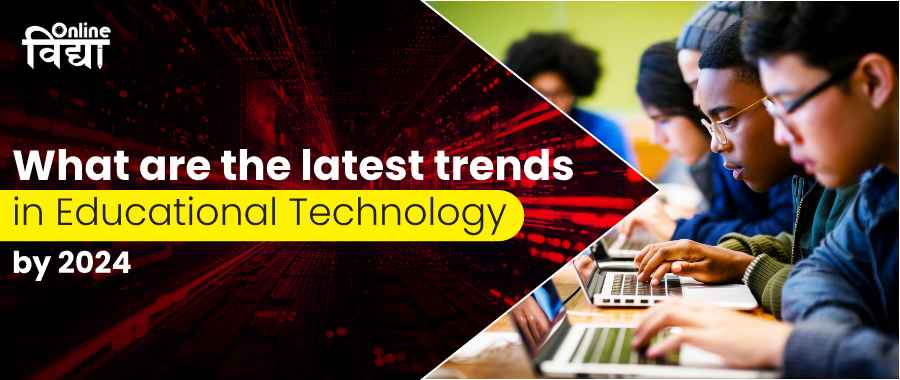Specializations
Courses Available
Courses

What are the latest trends in educational technology by 2024
What are the latest trends in educational technology by 2024,Oct 09, 2024
Information
Oct 09, 2024
2944 Views
- Share:
Technology is changing and broadening the way we live and interact. It changed the face of every field, every sector, in the best way. However education can positively change the world, it has been very behind related to technology adoption.
Education technology will overcome the present limitations that stand in the way of better quality education across the globe. Education technology will provide scope to enhance the imagination of students and learn things in a better way.
The latest and upcoming trends in education technology will benefit the education sector greatly as well as the entities involved, such as students, teachers, management, parents, etc. For this reason, we have compiled some of the key trends and technologies that might define trends for this or upcoming years.
1. E-Learning Platforms
E-learning portals have become more popular since the emergence of the Covid-19 pandemic in the world. The portals are offering quality educational content as well as instructors to students irrespective of their location in the world.
Above all, digital content platforms have vast numbers of learning resources available to students and teachers. With the increasing popularity of digital content platforms, the influence on the way of learning and interaction patterns related to educational content is bound to rise as well.
2. AI-Powered Environment
For example, facial recognition, natural language processing, and machine learning are being widely used in the classroom with the help of AI-enabled learning technologies so that learning is easy and more engaging for students.
The AI-powered learning environment provides students with personalized learning experiences and enables teachers to tailor the lesson according to the needs of different students.
Hence, it would not be wrong to say that AI is quick in its speed of being included in the schooling tools and the result surely would be observed in the coming years.
3. Gamification of Learning
Various educational institutions are adopting the trend of gamification in learning. This method is more engaging and fun for the students to take education with the help of the game elements. Students will be able to gain more information and build new skills with interactive and engaging learning.
4. Automation of Assessment
Certainly, education falls into no exception to the power play when it comes to automation. Automated assessment tools will be used rapidly from now on in evaluating the progress of students. This offers better insights into what has been done and what needs more effort from the classroom teachers and school administrators to bring out the best efforts in student performance.
Automated grading tools can also provide analysis data that will help students identify areas of weakness in their work as a way of focusing on improvement. Another thing is the ease with which automated grading tools help teachers grade assignments quickly and accurately, saving time on grading.
5. Cloud computing
Cloud Computing is always an important tool in education that allows students to access and store data more efficiently. It also helps students to save money on expensive books as it can be accessed easily anywhere. This also offers strong authentication facilities to ensure data security with the collaboration of students and teachers.
6. Social Media in Education
In today’s fast-paced education journey, social media impacts learning. It creates new opportunities to connect and share knowledge. It also plays an important role in teaching educators while giving them new tools and engagement opportunities.Working in its early stages has left a significant impact on the way of learning. In the upcoming years, social media will be highly impactful on the way of learning & teaching.
7. Augmented Reality and Virtual Reality (AR & VR)
Augmented & Virtual Reality helps create immersive learning environments for students. It rapidly increases the tool for engaging and immersive learning. Students get the chance to explore virtual reality, practice tasks, and simulations in engaging to tailor the student's needs. It will be hard to ignore the impact of education as both technologies become more commonplace.
Frequently Asked Questions
Q: What is the newest technology in education?
- Cloud Computing Facilitating Remote Education.
- Big Data and Learning Analytics.
- Internet of Things (IoT) in Smart Educational Environments.
- 5G Technology Accelerating Online Learning.
- Microlearning.
- Social Learning Platforms.
- Voice Assistants and Chatbots in Learning.
- Digital Twins in Education.
Q: What is new in Edtech?
A: AI-enabled adaptive Learning is a high-tech form of personalized learning. Digital learning interfaces can adapt to students' needs in real-time, offering the lessons and exercises that are needed to complete knowledge gaps and reinforce concepts.
Q: What is AI in education in 2024?
A: AI-powered tools can automate admin tasks, reduce overheads, and lower education costs. AI makes it possible to have a classroom where lessons adjust to each individual's strengths and weaknesses. A classroom where teachers get real-time feedback on how their students study.
Q: Can AI replace education?
A: Just as a calculator doesn't replace the need for understanding maths, AI won't replace the need for human connection, adaptability, and guidance in the classroom. The future of education doesn't lie in sterile, roboticised classrooms, but rather in a balanced blend of human expertise and technological support.
Q: Is AI good or bad for students?
A: Students gain problem-solving skills and work ethic from completing assignments in their academic careers that prepare them for their careers. Relying on AI to finish these tasks where they should be studying can be dangerous for students in the long run when they cannot think independently.

Meet Our Counselling Experts
Get 100% Free Career Counseling




PlacementPartners










Schedule Your 30 min Couselling Session With Today!!
Select a Date of your choice :
You Have Selected Slot on .

